At PetSweetJoy, we sometimes share products we truly love and use with our own pets. This post contains affiliate links, which means we may earn a small commission, at no extra cost to you. We only recommend products that fit our values of care, comfort, and responsible pet parenting.💗
Introduction: Why the Habitat Must Be an Ecosystem
Welcome to the fascinating world of reptile habitat setup, where creating the perfect home is as rewarding as caring for the animal itself. Lizards, snakes, and amphibians may look like miniature dinosaurs, but behind their calm stares and quiet habits lies one big truth: your reptile’s health depends almost entirely on the environment you build for them.
Unlike dogs or cats, reptiles can’t adapt to just any space. Their comfort, safety, and even survival hinge on the precision of your setup, the temperature, lighting, humidity, and layout all work together like gears in a living ecosystem. A well-planned reptile habitat setup isn’t just about looking good; it’s about mimicking nature’s rhythm so your scaly friend can feel secure and thrive.
Think of it this way: you’re not just decorating a tank, you’re designing a self-contained world that meets every biological need your pet would normally fulfill in the wild. When you get that balance right, everything else follows: strong immunity, healthy appetite, active behavior, and a happier, more confident companion.
At PetSweetJoy, we believe building a reptile’s home should feel exciting, not intimidating. Whether you’re welcoming your first bearded dragon or upgrading your gecko’s tank, this guide will walk you through each essential step, from choosing the right enclosure and lighting to maintaining perfect humidity.
By the end, you’ll know exactly what your reptile needs to feel at home, and you’ll be ready to create a safe, species-specific ecosystem that thrives year-round.
Researching Your Reptile’s DNA (The Species-Specific Mandate)
Before you even buy the first piece of décor or heating lamp, take a moment to do what every great reptile parent does first, study your pet’s roots.
Each species comes with its own story written in its DNA. That story tells you what kind of environment, food, and rhythm of life it truly needs to thrive. And when it comes to building a healthy reptile habitat setup, understanding where your reptile comes from is everything.
Natural Origins and Environmental Needs
Every reptile is shaped by the landscape it evolved in. Some have learned to bask under scorching desert suns, while others spend their days high in humid rainforest canopies. Recreating that natural balance is what separates a “tank” from a thriving ecosystem.
Here are a few simple but powerful questions to ask yourself before you start shopping for reptile enclosure essentials:
- Where does my reptile come from?
Is it a sun-loving desert dweller like a bearded dragon, or a humidity-seeking species like a chameleon or tree frog? Each one needs a completely different temperature and moisture balance. - How does it move and live?
Arboreal species (like geckos or chameleons) need height and climbing branches. Terrestrial reptiles (like leopard geckos or snakes) feel safer in wide, low setups with multiple hides. - When is it most active?
Diurnal reptiles soak up sunlight during the day, while nocturnal ones prefer cooler, dimly lit environments at night. Lighting plans should match that rhythm. - What does it eat?
Insectivore, herbivore, omnivore, diet influences not only what goes in the food dish but also humidity levels and substrate choice.
💡 Pro tip: If you’re unsure where to begin, our post “Top Reptile Habitat Mistakes Beginners Make” walks you through the most common early setup errors (and how to avoid them). It’s a great checklist to pair with your first terrarium plan.
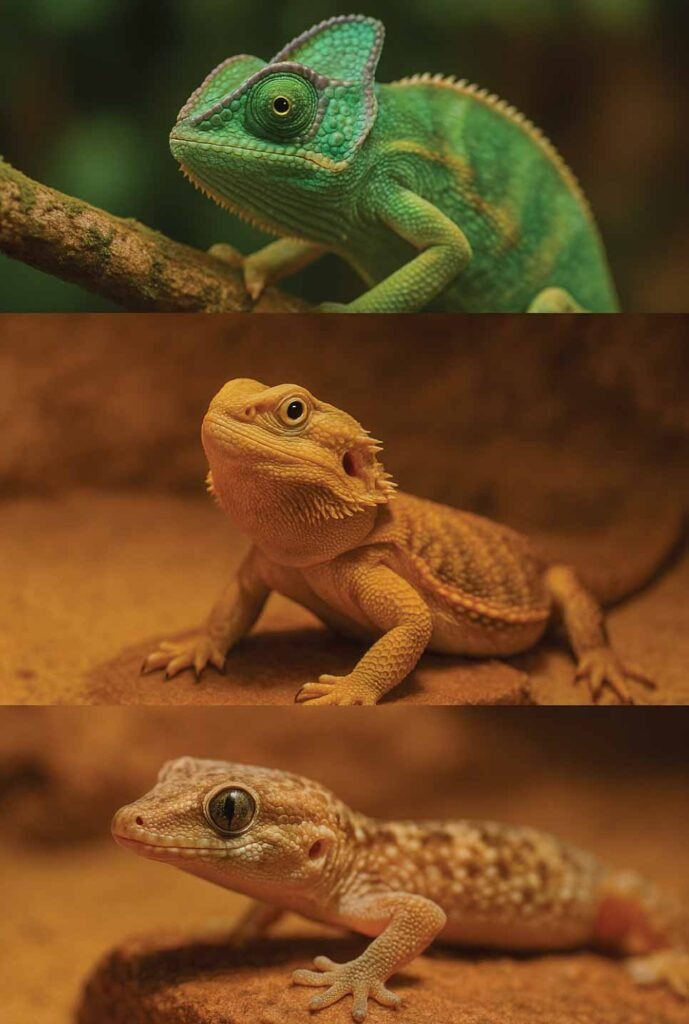
Why Subtle Differences Matter
Here’s the thing, even tiny mismatches in temperature or humidity can cause big problems down the road. Reptiles are masters of adaptation in the wild, but in captivity, they depend completely on you to get those micro-details right.
Common issues often come down to setup mistakes:
- Respiratory infections may appear when humidity is too high or airflow too poor.
- Impaction happens when loose substrates (like sand or gravel) are accidentally swallowed.
- Metabolic Bone Disease (MBD) develops when UVB exposure or vitamin D₃ intake is too low, preventing proper calcium absorption.
If you’ve ever read about these conditions on trusted sites like The Spruce Pets or Reptiles Magazine, you’ll know they’re sadly common, but also highly preventable with the right setup and nutrition.
🦎 Friendly reminder: It’s always okay to double-check your enclosure plan with a reptile-savvy veterinarian. A quick consultation before you bring your pet home can save you stress (and vet bills) later.
Personal Note from PetSweetJoy
When I cared for my first turtle years ago, I learned this lesson the hard way. I assumed “warm” meant warm enough and that a simple lamp would do. It didn’t. Once I adjusted the basking light, added a proper UVB bulb, and matched the tank’s humidity to her natural habitat, she became livelier almost overnight. That’s when it clicked, the setup is the care.
Understanding your reptile’s unique biology isn’t just responsible ownership, it’s the foundation of a joyful, stress-free bond. And if you’re just starting out, this step is where you truly become a reptile keeper, not just an owner.
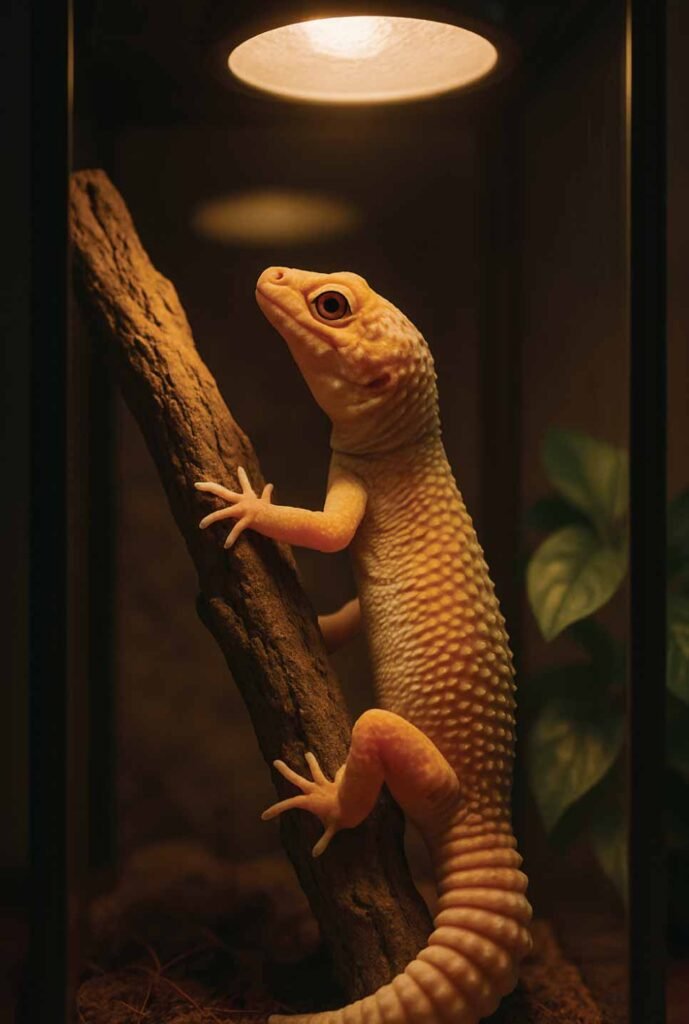
Mastering the Climate Control Trinity
Reptiles are like solar-powered friends, they depend on the environment, not internal heat, to function. That’s why every successful reptile habitat setup starts with mastering three essentials: temperature, lighting, and humidity. Together, they form what we call the Climate Control Trinity, the invisible force keeping your scaly buddy happy, active, and healthy.
Temperature: The Thermoregulation Key
Your reptile doesn’t just like warmth, it needs it to digest food, absorb nutrients, and fight infection. But not all heat is created equal. The secret lies in creating a thermal gradient, a natural temperature range that lets your pet move freely between warm and cool areas to self-regulate, just like it would in the wild.
Here’s how to build it right:
- The Warm Side (Basking Area): This should reach the high end of your species’ preferred range, for many reptiles, that’s between 90°F and 100°F.
- The Cool Side: Keep it comfortable, around 70°F–85°F, depending on the species.
- Nighttime: Temperatures can safely drop slightly at night but should never fall below the species’ minimum comfort level.
💡 A reliable heating setup can make or break your reptile’s well-being.
For beginners, a complete Heating Set (Lamp + Heat Emitter 75W) from Exotic Nutrition is an excellent starter choice. It provides steady warmth without harsh light and pairs well with a thermostat for round-the-clock regulation.
You can also add a Ceramic Heat Emitter for night use, it emits heat without disrupting your pet’s sleep cycle, which is especially handy for nocturnal species.
Tip: Always regulate your heat sources with a compatible thermostat. It’s tempting to “eyeball” temperatures, but that’s risky. A small overheat can quickly become dangerous. Use two or three digital thermometers to track conditions across the tank, one on the warm side, one on the cool side, and one in the middle for the ambient reading.
If you’re new to reptile care, check out our related guide on Responsible Reptile Ownership: Do’s and Don’ts for other must-have safety practices.
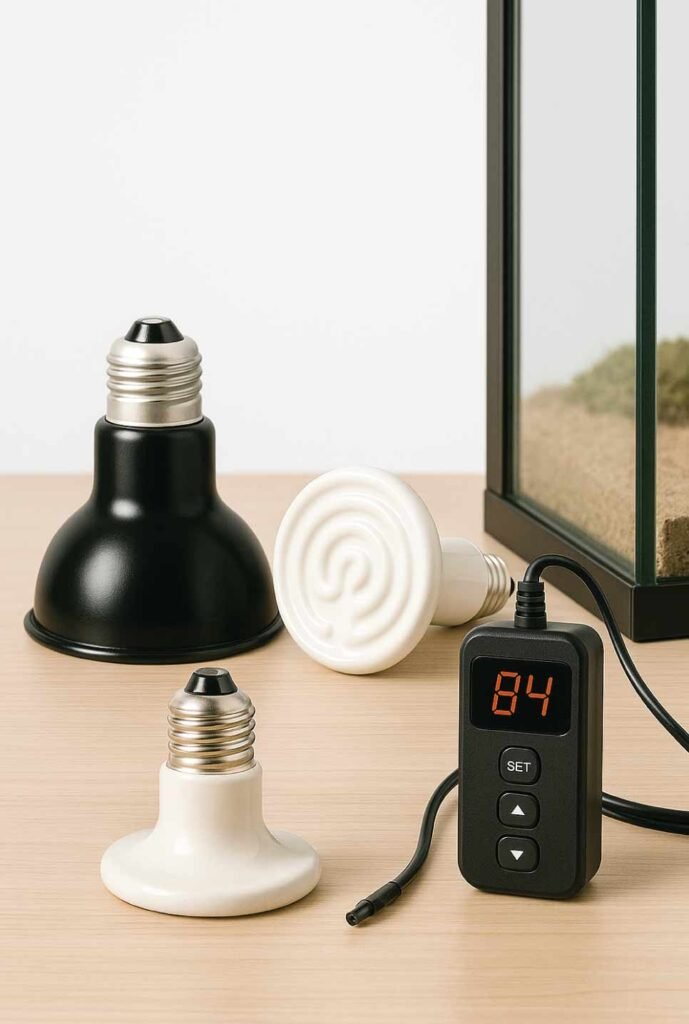
Lighting: UVB and D₃ Synthesis
This is where many beginners stumble. A basking light may look bright enough, but standard household bulbs can’t replace real UVB.
Why UVB matters:
Day-active reptiles use UVB rays to produce Vitamin D₃, which helps them absorb calcium from food. Without it, they’re prone to Metabolic Bone Disease (MBD), a painful, preventable condition that weakens bones and joints.
For a stress-free setup, you can go for a UVB Set (Gooseneck Lamp with Dome + UVB Bulb 26W). It’s easy to mount and delivers the right intensity for many beginner species like leopard geckos or bearded dragons.
A few practical reminders:
- Keep the UVB bulb within 12 inches of your pet’s basking spot for optimal exposure.
- Replace bulbs every 6–12 months, even if they still shine, their UV output fades over time.
- Always provide shaded spots so your reptile can move out of the light when it wants to.
Fun fact: UVB exposure not only supports bone health but also boosts your reptile’s mood and activity, they actually “sunbathe” when they feel good!
Humidity and Ventilation
Humidity often gets overlooked, yet it’s the final piece that makes your habitat feel “alive.” It affects hydration, shedding, and even respiratory health.
- Use a hygrometer to measure humidity accurately (guessing won’t cut it).
- Tropical reptiles, like chameleons and crested geckos, need higher humidity, often 70–90%. You can mist daily or use a fogger.
- Desert species, like bearded dragons, prefer dry air, around 30–40%. Over-humid conditions can lead to respiratory infections.
- Airflow is key: Proper ventilation keeps humidity balanced and prevents mold buildup.
💧 Some keepers find a small Pet Warming Pad (20W) helpful for maintaining mild warmth and preventing condensation, especially during colder months.
🌿 For advanced setups, The Spruce Pets offers a great overview of how humidity affects reptile health, a perfect companion read as you fine-tune your own enclosure design.
Here’s the golden takeaway:
Your reptile’s comfort zone isn’t one number, it’s a range. Getting that natural variation right is the foundation of a thriving reptile ecosystem.
When you nail this Climate Control Trinity, everything else, appetite, shedding, even personality, falls into balance.
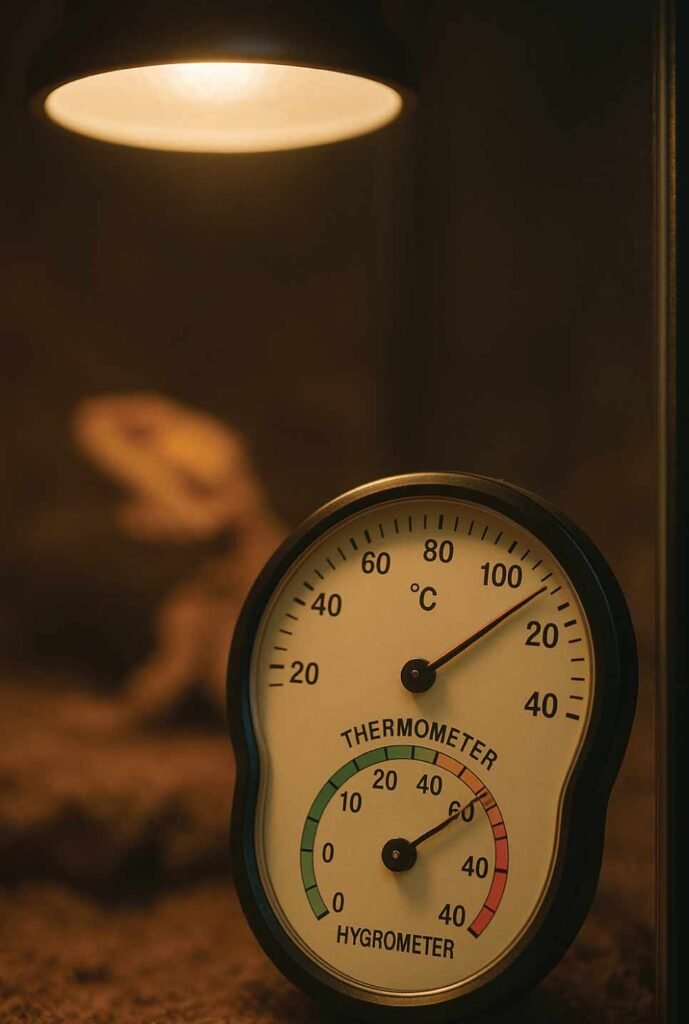
Building the Safe Enclosure and Decor
Once your temperature, light, and humidity are under control, it’s time to focus on the fun part, creating a safe, enriching home that lets your reptile explore, climb, and rest naturally. Think of this as designing both a playground and a sanctuary.
The right reptile enclosure setup balances function, safety, and beauty. Every branch, rock, and hide you add should serve a purpose: helping your reptile feel secure, behave naturally, and stay healthy.
Choosing the Right Enclosure
Let’s start with the “home” itself. The enclosure is more than a container, it’s the foundation of your reptile’s well-being.
Different reptiles need different homes, so choose one that matches your pet’s habits:
- Arboreal species (like chameleons or crested geckos) thrive in taller cages with strong vertical climbing areas.
- Terrestrial species (like bearded dragons or snakes) prefer wider enclosures that allow room to roam and bask.
If you’re looking for a reliable, beginner-friendly setup, the Arboreal Reptile Cage is a fantastic choice. It’s built for species that love to climb, with secure ventilation and elegant, clear acrylic sides that make it easy to enjoy watching your reptile explore.
For ground dwellers, the Front-Loading Reptile Enclosure stands out. Its lockable front panel and removable drawer make daily cleaning a breeze, and the extra space at the bottom allows you to add substrate safely.
And if you ever need something unique (say, a custom size for a specific snake or amphibian), Lorex Plastics can even custom-build enclosures to your specifications, a rare perk for serious reptile keepers who want their setup to evolve with their pet’s needs.
🐍 PetSweetJoy Tip: If you’re upgrading from a smaller tank to one of these enclosures, move your reptile gradually. Keep familiar hides and décor pieces inside the new space so it feels safe and familiar.
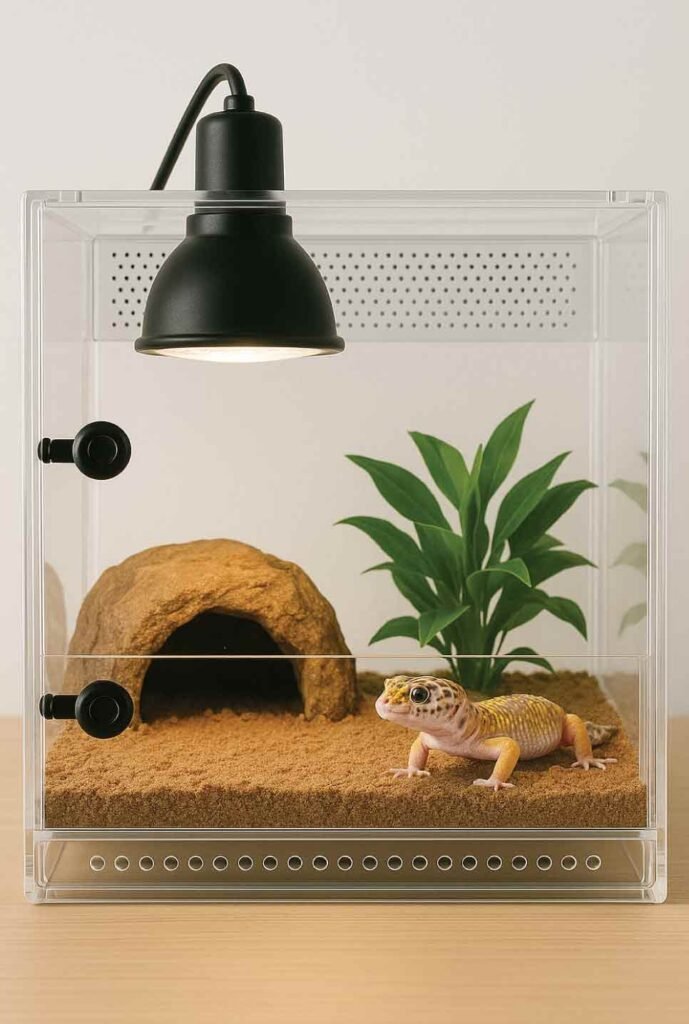
Substrate and Interior Hardscape
The substrate isn’t just “bedding”, it affects comfort, humidity, and even health. Choose a base that mimics your reptile’s natural terrain:
- Desert dwellers: Use reptile-safe sand blends or a mixture of clay and topsoil for stability.
- Tropical reptiles: Go for moisture-retaining materials like coconut fiber, moss, or bioactive soil mixes.
🚫 Avoid cedar and pine shavings. Their aromatic oils can irritate your reptile’s skin and respiratory system.
⚠️ Watch for impaction risks: Loose substrates like fine sand can be swallowed accidentally during feeding, leading to digestive blockages. Feeding in a separate area or using a feeding dish (like a shallow ceramic bowl) can help prevent this.
If you’re curious about safe substrate combinations, check out our blog Reptile Health Tips, it’s packed with practical, species-specific advice from real reptile parents.
Critical Safety and Toxin Avoidance
A gorgeous enclosure means nothing if it’s unsafe. Some materials, even natural ones, can cause serious harm if not treated properly.
Here’s what to watch out for:
- Outdoor décor: Avoid bringing in branches, driftwood, or rocks from outside unless you’ve sterilized them thoroughly. Parasites, fungi, or chemical residues can linger on untreated materials.
- To sanitize safely, soak the items in a mild bleach-and-water solution for 24 hours, then rinse and soak again in clean water for another 24 hours.
- Metal toxicity: Avoid copper, zinc, or lead, these can leach harmful substances into humid environments.
- Plant safety: Some houseplants are toxic to reptiles. Always double-check species before adding greenery.
Lorex Plastics enclosures make this easier with acrylic panels that don’t corrode or absorb moisture, giving you the beauty of a natural setup without the safety risks of untreated wood or metal frames.
🔥 Heating safety tip: Always mount heat lamps above the enclosure or protect them with guards. Reptiles are naturally curious and can easily burn themselves if a heat source is too close.
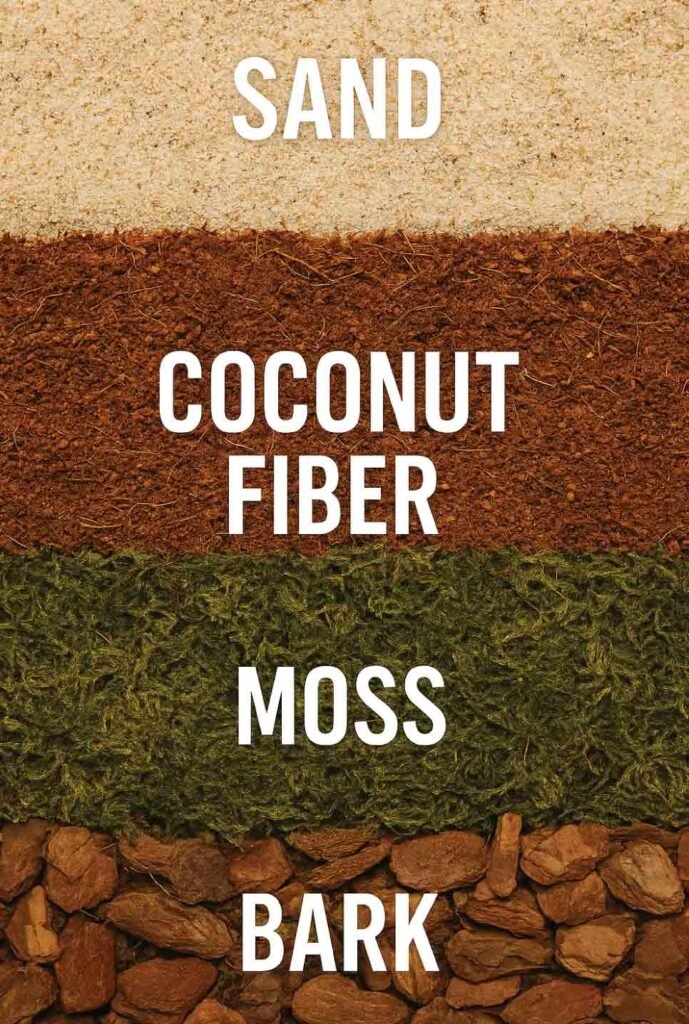
Hides and Enrichment
Even the most social reptiles need private spaces. In nature, hiding is a form of self-care, it helps regulate stress and temperature.
- Provide at least two hides: One on the warm side and one on the cool side. This lets your reptile retreat while staying within its comfort zone.
- Add climbing structures: Branches, cork bark, and vines are perfect for arboreal species.
- Encourage exploration: Re-arrange safe décor occasionally. A small change can re-spark your reptile’s curiosity and reduce boredom.
If you’re creating a semi-natural layout, consider adding textured rocks or platforms to help with shedding and claw health. Many reptile parents also use raised platforms or small hammocks, your reptile will pick favorites faster than you think!
Key takeaway:
A perfect reptile enclosure isn’t about how fancy it looks, it’s about how functional and safe it feels to the animal living inside.
When you combine the right enclosure, substrate, and décor with love and consistency, you’re not just keeping a reptile, you’re creating a miniature world where it can live, grow, and feel at peace.
Advanced Setup and Professional Practices
Once you’ve mastered the basics, it’s time to fine-tune your reptile’s world. These advanced practices turn an ordinary enclosure into a stable, living ecosystem that practically runs itself, the gold standard for responsible reptile care.
The 48-Hour Enclosure Test Run
It’s tempting to rush once your new setup looks picture-perfect, but patience here pays off.
Before bringing your pet home, run the full habitat for at least 48 hours.
This test period lets you confirm that temperatures, humidity, lighting cycles, and ventilation remain consistent through day and night.
Why this matters:
- Heating devices sometimes run hotter than expected once the lid is on.
- Nighttime temps may drop too sharply without realizing it.
- Foggers or misters can over-humidify in closed rooms.
Think of it as a “dress rehearsal” for your reptile’s new life. A stable, predictable climate means less stress from day one, and you’ll sleep better knowing their environment is already in balance.
🧡 PetSweetJoy tip: Keep a simple notebook or digital log during this test run. Record temperature and humidity at morning, midday, and night. Patterns often reveal small tweaks that make a big difference.
Enclosure Type and Construction
Your reptile’s comfort isn’t only about gadgets, the materials and shape of the enclosure play a huge role.
Glass or PVC enclosures work best for humid or semi-aquatic species. They retain moisture beautifully and resist warping.
Wooden vivariums are better for dry, desert-style setups because they insulate heat efficiently.
Whatever you choose, size it for the adult animal, not the baby. Many keepers underestimate how quickly young reptiles grow, which leads to cramped living conditions within months.
A few quick guidelines:
| Reptile Type | Ideal Shape | Example Setup Idea |
|---|---|---|
| Bearded Dragon | Wide and low | Front-loading desert vivarium |
| Chameleon | Tall and ventilated | Arboreal cage with UVB dome |
| Snake | Long and secure | Sliding-door terrarium with multiple hides |
If you’re ever unsure about the right fit, the Front-Loading Reptile Enclosure mentioned earlier adapts well to both desert and temperate species thanks to its roomy base and ventilation panels.
Embracing the Bioactive Approach
A bioactive setup is like bringing a piece of the jungle or desert right into your living room, but in miniature. It’s one of the most exciting trends in reptile care because it makes maintenance easier while giving your pet a more natural environment.
What is a bioactive habitat?
It’s an enclosure that includes living plants, organic soil, and a tiny clean-up crew of beneficial insects that recycle waste. Over time, these micro-organisms create a self-cleaning, self-balancing ecosystem.
Benefits:
- Reduces odor and bacterial buildup
- Keeps humidity more stable
- Encourages natural digging and exploring
- Looks absolutely stunning
Clean-Up Crew (CUC):
Isopods and springtails are your best friends here. They nibble on decaying material, keeping the soil healthy. You can find them in most reptile supply stores or through specialty breeders.
Soil Selection:
Use a layered substrate with drainage balls or mesh at the bottom, topped with coconut fiber and leaf litter. This combination encourages plant growth and supports your CUC.

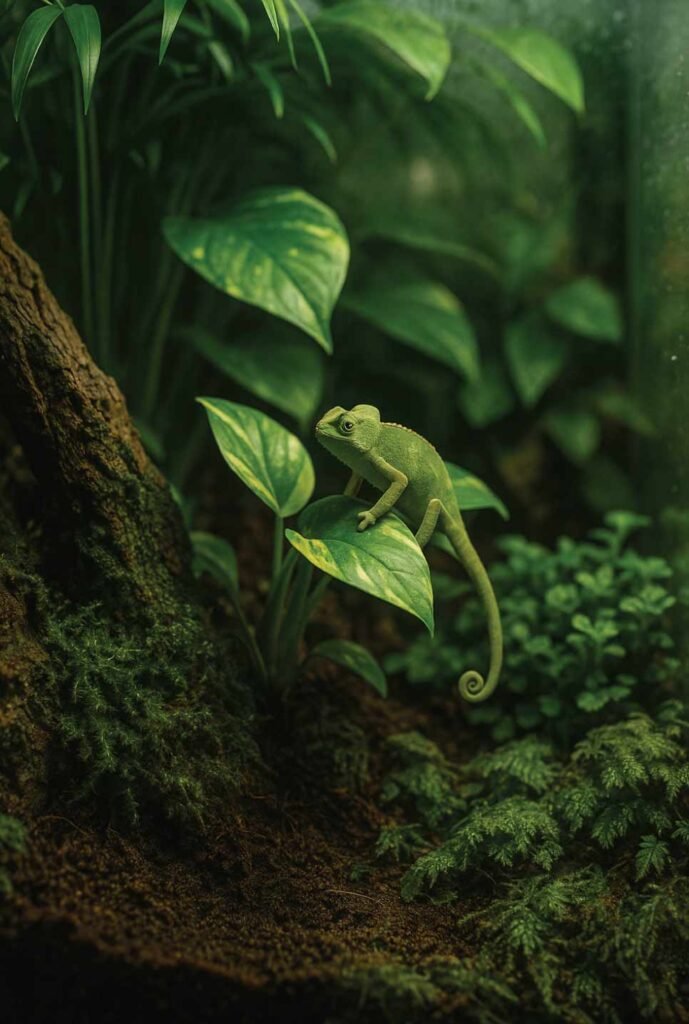
Automation & Self-Regulating Systems
If you love technology, this part’s for you.
Timers, thermostats, and smart plugs can turn your reptile habitat setup into a low-stress routine:
- Smart timers keep day/night cycles consistent.
- Digital thermostats prevent overheating or sudden drops.
- Automatic misting systems make maintaining humidity effortless, especially when you’re away for the weekend.
These upgrades might sound fancy, but they’re really about peace of mind. They ensure stability, which translates directly into health and longevity for your reptile.
Continuous Observation and Adjustment
Even with the best tools, your reptile will tell you how it feels, you just have to watch closely.
- If your bearded dragon basks constantly, the cool side may be too cold.
- If your gecko hides all day and night, it may be feeling overstressed or too hot.
- Cloudy eyes or dry skin can indicate low humidity.
Your reptile’s behavior is the most accurate “sensor” you’ll ever own.
💬 Want to learn more about reading those signs? Our post Reptile Health Tips breaks down subtle body-language cues that often go unnoticed by beginners.
Key takeaway:
Building an advanced enclosure isn’t about complexity, it’s about consistency. When light, heat, moisture, and care routines stay steady, your reptile learns to relax and behave naturally.
Monitoring, Health, and Expert Consultation
Even the most beautifully designed reptile habitat setup needs one last ingredient to truly thrive, you.
Your daily care, quiet observations, and small adjustments are what turn a tank into a living home.
Diet, Hydration, and Supplements
A healthy reptile starts with proper nutrition. Just like us, they need a balanced diet that supports growth, energy, and strong bones.
Diet diversity matters:
Some reptiles are strict insectivores, while others thrive on leafy greens, fruits, or a mix of both. Make sure the diet reflects their natural preferences.
- Insect-eating reptiles (like leopard geckos or bearded dragons) enjoy mealworms, crickets, and the occasional waxworm treat.
- Herbivorous reptiles (like iguanas or uromastyx) need a variety of fresh greens, kale, dandelion, and collard leaves are top choices.
💚 Supplementation tip: To support bone health and prevent Metabolic Bone Disease (MBD), dust insects or veggies with Rep-Cal Ultrafine Calcium with Vitamin D₃ or Rep-Cal Herptivite Multivitamin a few times per week. These two products are reptile-keeper classics for a reason, they’re trusted by hobbyists and veterinarians alike.
💧 Hydration: Always provide access to clean, fresh water. Replace it daily, and wash the dish often to prevent bacteria buildup. For ground-dwellers, a shallow bowl is perfect. Arboreal species may prefer dripping or misting systems that mimic rainfall.
A simple No-Escape Mealworm Feeding Dish can make feeding time much cleaner, no more crickets jumping out or mealworms hiding under décor!
🐢 PetSweetJoy Note: Place water bowls and feeding dishes on the cooler side of the tank to slow bacterial growth and maintain better temperature balance.

Maintenance and Health Checks
A clean environment equals a healthy reptile. Routine maintenance helps prevent bacteria, mold, and parasite buildup.
- Spot clean daily: Remove droppings, shed skin, and uneaten food.
- Deep clean weekly: Replace substrate and disinfect surfaces with a reptile-safe cleaner.
- Watch behavior closely: Small changes often reveal bigger issues.
Signs of good health:
- Clear, alert eyes
- Steady appetite
- Smooth skin and consistent shedding
- Normal movement and energy
Red flags to act on:
- Lethargy or constant hiding
- Loss of appetite
- Discolored or crusty skin
- Soft jaw or bones (possible calcium deficiency)
If you notice any of these, it’s time to reach out to a reptile-savvy vet. Many early health issues are reversible when caught quickly.
For deeper insight into common issues, check out our article on Reptile Health Tips.
Consulting the Specialists
Even with years of experience, every reptile parent occasionally needs professional advice. There’s no shame in that, it’s part of responsible ownership.
🐍 When to consult a reptile veterinarian:
- After major setup changes (new lighting, heating, or substrate)
- When you notice unusual shedding, swelling, or behavior changes
- For annual wellness checks
Veterinarians specializing in exotic pets can run diagnostics that go far beyond what’s visible at home. Their input can be the difference between a mild issue and a serious health condition.
Emergency tip: If your reptile shows signs of labored breathing, mouth swelling, or vomiting, seek veterinary help immediately, these may indicate toxicity or severe infection.
Remember, as National Geographic often reminds readers, reptiles may seem stoic but are surprisingly sensitive creatures. When given attentive, species-appropriate care, they reward their humans with calm companionship and years of fascination.
Frequently Asked Questions About Reptile Habitat Setup
A good beginner reptile habitat setup includes a secure front-loading enclosure, a heat source with a thermostat, a UVB light, and a humidity monitor.
Front-loading enclosures from Reptile Enclosure and complete heating and lighting sets from Exotic Nutrition are excellent starter options because they combine safety, visibility, and ease of maintenance.
Create a temperature gradient inside the enclosure. Keep one side warmer with a heat lamp or ceramic heater, and the other slightly cooler so your reptile can self-regulate its body temperature.
Always use a thermostat to avoid overheating and monitor with two or three thermometers placed across different zones.
Every healthy reptile setup needs:
- The right-sized enclosure for your species
- A safe, species-appropriate substrate
- Reliable heating and lighting equipment
- Proper humidity control
- Enrichment features like hides, climbing structures, and clean water dishes
These essentials help create a balanced and secure environment where your reptile can thrive.
Yes, UVB lighting is essential for reptiles that are active during the day. It helps them synthesize Vitamin D₃, which is needed to absorb calcium and prevent Metabolic Bone Disease (MBD).
For beginners, a UVB Set (Gooseneck Lamp + Dome + UVB Bulb) from Exotic Nutrition provides both safe light exposure and easy installation.
Do light cleaning daily by removing droppings, uneaten food, and shed skin. Once a week, replace part of the substrate and disinfect décor and surfaces with a reptile-safe cleaner.
Deep cleaning every month helps maintain long-term hygiene, especially in humid setups where bacteria grow faster.
Healthy reptiles are alert, have clear eyes, shed regularly, and show steady appetite and activity.
Warning signs to look out for include loss of appetite, dull skin, difficulty shedding, or lethargy. If you notice any of these, consult a reptile-savvy veterinarian for a health check.

Conclusion: Bringing It All Together
Creating the perfect reptile habitat setup is both an art and a science. It’s about learning what makes your species tick, building an environment that mirrors nature, and then watching that little world come alive.
The magic happens when your reptile begins to thrive, not just survive. When it basks confidently under the lamp you set up, explores new branches, or calmly eats from your hand, you’ll know every minute spent planning was worth it.
At PetSweetJoy, we believe that caring for reptiles teaches patience, mindfulness, and empathy, values that make us better humans, too. Each habitat you build is a quiet promise: “I’ll keep you safe, warm, and understood.”
If you’re just starting out, take your time and enjoy the process. You’ll learn as you go, and your reptile will teach you even more along the way.
💡 Explore next:
- Top Reptile Habitat Mistakes Beginners Make
- Responsible Reptile Ownership: Do’s and Don’ts
- Reptile Health Tips for Their Best Care
🐾 And if you’re ready to enhance your own reptile’s world, check out our favorite Exotic Nutrition and Lorex Plastics products mentioned throughout this guide, thoughtfully chosen to make your setup safer, cleaner, and more enjoyable for both of you.
Because when your reptile feels at home, you will too. 💚




